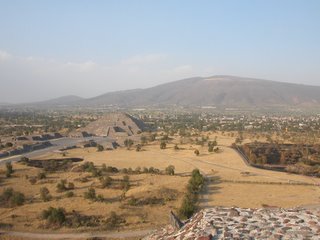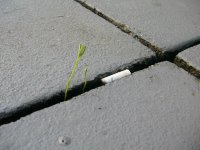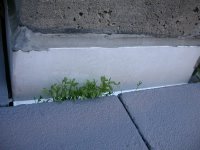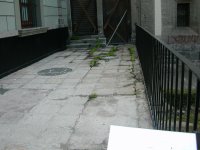
S/XL
"The architectural principle at work in [Pueblo] dwellings...is that of the imitation of natural forms by human beings who seek to fit themselves safely into nature's order. When the resources of large populations made it possible to build monumental architectural forms of communal function and at the landscape's scale, exactly the same principle was brought to bear. We can see it at work at Teotihuacan, which in all likelihood was the most important ceremonial center the North American continent ever produced. There the long axis of the site is traversed by an avenue called 'of the Dead'...
At Teotihuacan the Avenue of the Dead runs straight toward the pyramidal notched mountain, the Cerro Gordo....Directly below it lies the Temple of the Moon, at once repeating and compacting its profiles. The shape of the mountain is echoed but intensified by human symmetry and geometry; its power is thus harnessed and abetted. Men, as in human sacrifice, are helping nature along, forcing it to function, just as they fed it with their blood."
--Vincent Scully, America: The Sacred Mountain
This essay was one of our first readings for Landscape History class last semester. Scully is an old-school humanist; you can almost hear him getting choked up as he describes tribal rain dancers, willing the gods and nature to deliver to mankind "as they damn well ought to." We saw Teotihuacan, about an hour north of Mexico City, on the last day of our trip. Your strongest feeling, especially when you've climbed the impossibly steep steps of the pyarmids, is not of harnessing or abetting, but getting knocked around by the wind, and seeing how small the Temple of the Moon appears compared to the mountains behind it.
Later in the essay, Scully quotes Bernal Diaz, who travelled with Herman Cortez during the Spanish conquest of Mexico.
"Some of our soldiers even asked whether the things that we saw were not a dream. It is not to be wondered at that I here write it down in this manner, for there is so much to think over that I do not know how to describe it, seeing things as we did that had never been heard of or seen before, not even dreamed about...I say again that I stood looking at it and thought that never in the world would there be discovered other lands such as these...of all these wonders that I then beheld today all is overthrown and lost, nothing is left standing."
I love adult expressions of wonder. Desdemona describing Othello. The New England colonists seeing for the first time the glut of salmon in the streams, the endless supply of wood in the forests. Giddy science writers talking about genes.
 Last fall, in the middle of some god-awful near all-nighter, Danielle and I tried to invent some new procrastination games out on the 4th floor patio. With lentils, which I was using in my model to represent stones. The best we could do at 2am, exhausted, with our creative energies dry as the beans, was to spill a bunch of lentils on the outdoor stairs. Instant fun! Lentil-coated stairs! Then realizing what a lame trick this was, we tried to sweep the evidence into the crack between the staircase and the cement patio floor.
Last fall, in the middle of some god-awful near all-nighter, Danielle and I tried to invent some new procrastination games out on the 4th floor patio. With lentils, which I was using in my model to represent stones. The best we could do at 2am, exhausted, with our creative energies dry as the beans, was to spill a bunch of lentils on the outdoor stairs. Instant fun! Lentil-coated stairs! Then realizing what a lame trick this was, we tried to sweep the evidence into the crack between the staircase and the cement patio floor.
 Fast forward to a week later, when suddenly little green shoots had sprung up in those cracks, taking root in the few morsels of soil, glass, and cigarette butts. Thanks to a mild November, by Thanksgiving we had a wild bush of lentil plants growing alongside the stairs.
Fast forward to a week later, when suddenly little green shoots had sprung up in those cracks, taking root in the few morsels of soil, glass, and cigarette butts. Thanks to a mild November, by Thanksgiving we had a wild bush of lentil plants growing alongside the stairs.
Then it became an International Art Phenomenon. In Mexico City we saw two separate projects along the same lines. An anthology called espacio included a project in which the artist created a small halo of plants-in-rooftop-crack and invited people to lay down with their heads nestled among the green. And by the Alameda Park, the Printmaking Museum had an outdoor installation piece of green-in-crack, pictured below.
In the end, all my best ideas always get ripped off.



0 Comments:
Post a Comment
<< Home